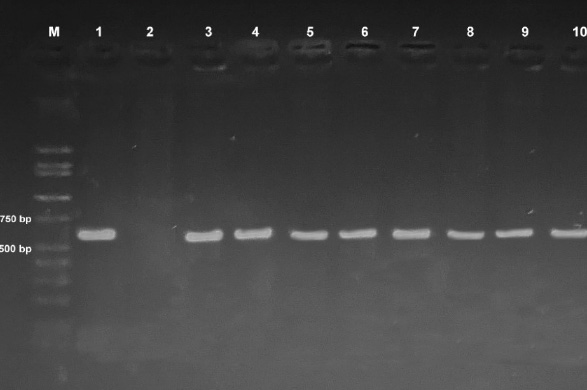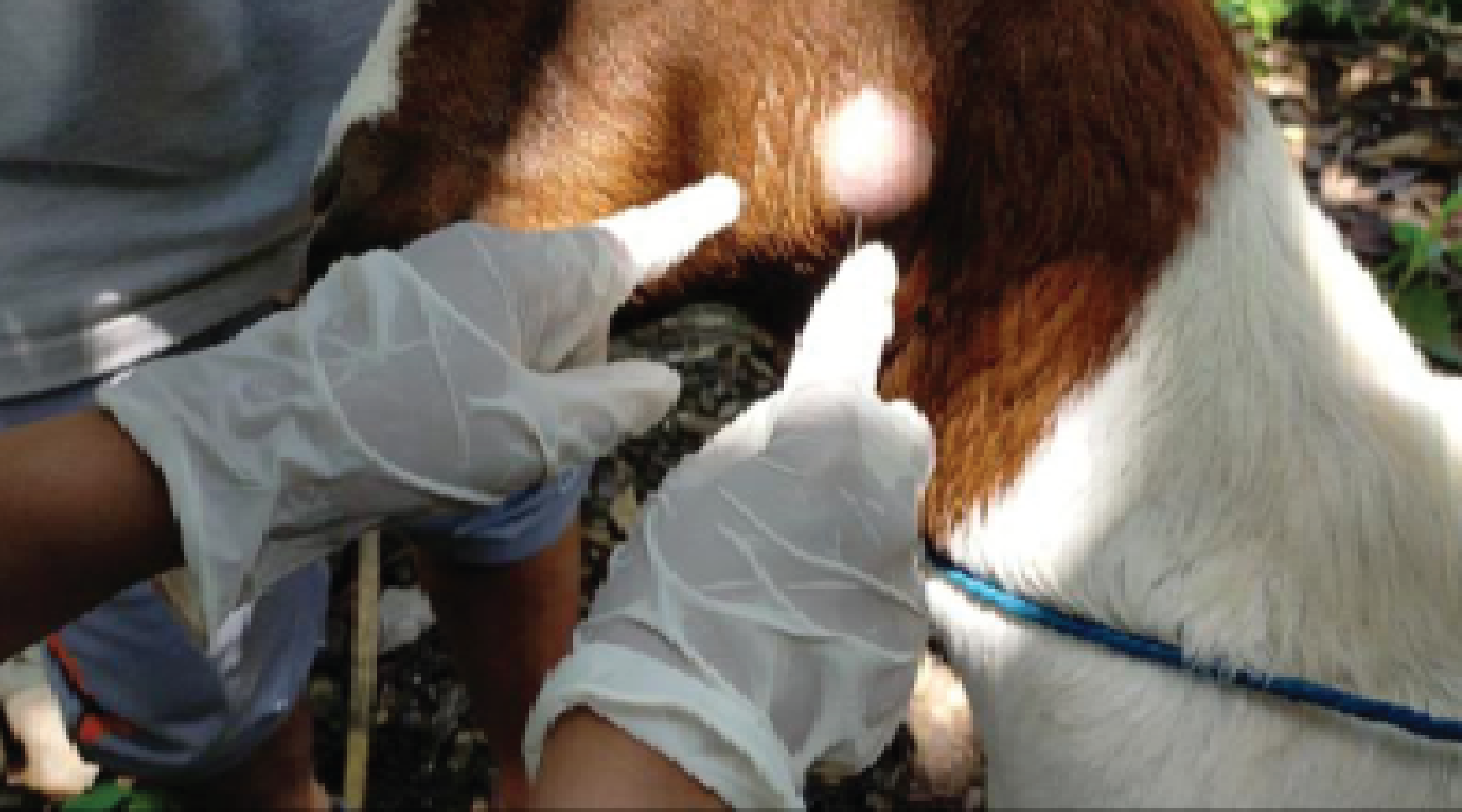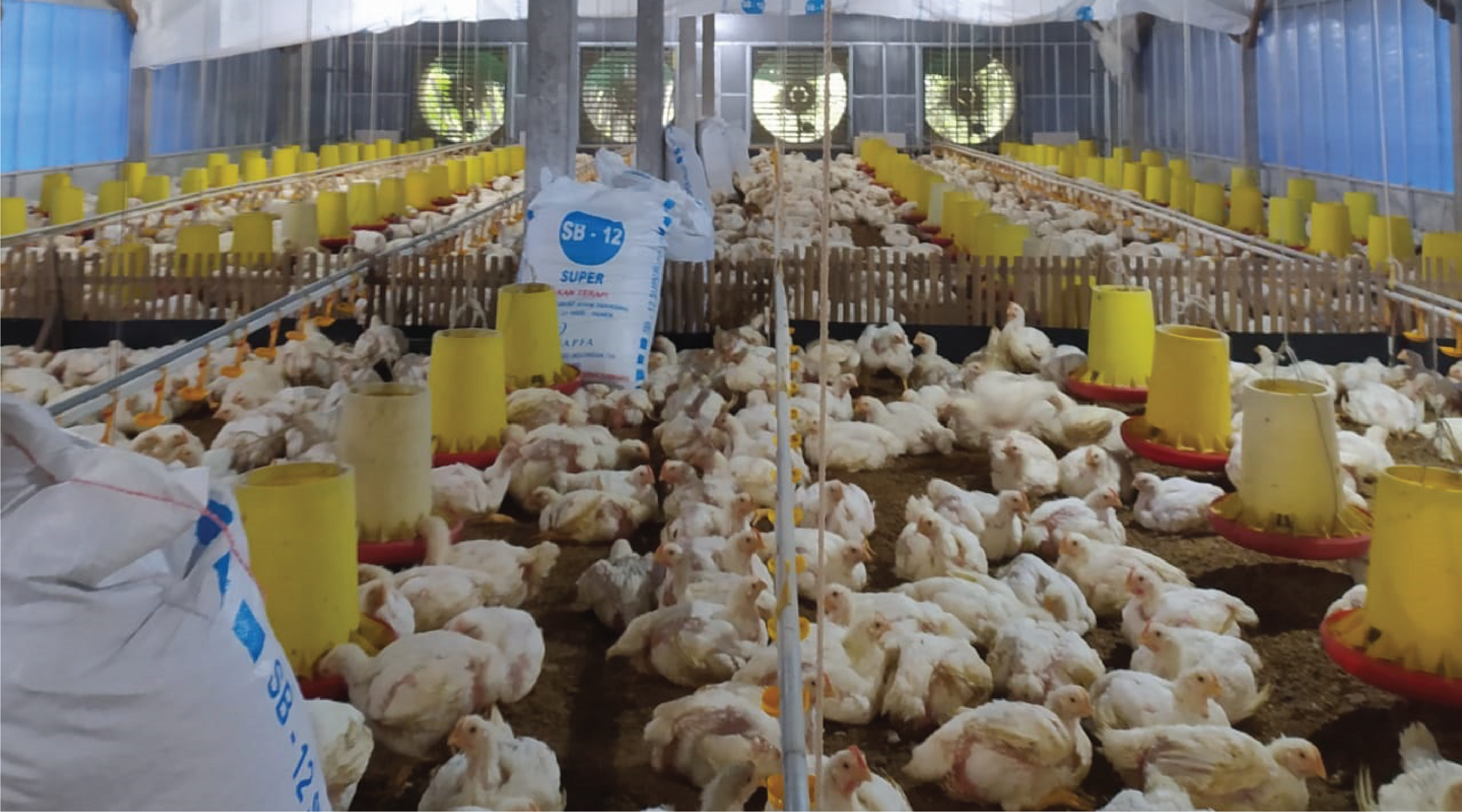Seasonal Variation on The Prevalence and Molecular Characterization of Trypanosoma species from Rodents Trapped in Kilombero District, Tanzania

Downloads
Background: Trypanosomiasis is a disease mainly encountered in tropical regions and is significant to both humans and animals. Rodents and their fleas have been found to play a major role in the transmission of trypanosomiasis to humans. Purpose: This study aimed to examine the seasonal variation and molecular characterization of Trypanosoma species from rodents in Kilombero. Method: The study employed a cross-sectional design. A total of 387 rodents were captured, and anesthetized with Diethyl Ether to collect blood, spleen, and liver. Rodent tissues were tested with conventional PCR and sequencing to target the 18S rRNA and ITS1 genes. Results: The most prevalent species was Mastomys natalensis 82.43% (319/387), followed by Rattus rattus 16.79% (65/387), Gramomys spp. 0.52% (2/387), and the least captured species Lemnscomys spp. 0.26% (1/387). Overall microscopic prevalence was 38.76% (n=150/387), and PCR indicated prevalence of Trypanosoma spp. to be 6.28% (n=10/159). Male rodents had a higher molecular prevalence of Trypanosoma spp., and a higher molecular prevalence of Trypanosoma spp. was observed in the dry season. Conclusion: Detection of T. lewisi from the rodents shows the public health significance in the study area. As a result, it is critical to use prevention and control measures in rodents to minimize potential human exposure within the area.
Alavaisha, E., 2020. Agricultural Expansion Impacts on Wetland Ecosystem Services From Kilombero Valley, Tanzania. Stockholm: Department of Physical Geography, Stockholm University.
Aleman, A., Guerra, T., Maikis, T.J., Milholland, M.T., Castro-Arellano, I., Forstner, M.R.J., and Hahn, D., 2017. The Prevalence of Trypanosoma cruzi, the Causal Agent of Chagas Disease, in Texas Rodent Populations. EcoHealth, 14(1), 130–143.
Archer, C.E., Schoeman, M.C., Appleton, C.C., Mukaratirwa, S., Hope, K.J., and Matthews, G.B., 2018. Predictors of Trypanosoma Lewisi in Rattus Norvegicus from Durban, South Africa. Journal of Parasitology, 104(3), 187–195.
Avalos-Borges, E.E.,Rios, L.E., Jiménez-Coello, M., Ortega- Pacheco, A., and Garg, N.J., 2022. Animal Models of Trypanosoma Cruzi Congenital Transmission. Pathogens, 11(10), 1172.
Babyesiza, W.S., Katakweba, A., Fornůsková, A., Ssuunaf, J., Akoth, S., Mpagi, J., Goüy De Bellocq, J., Bryja, J., and Votýpka, J., 2024. Trypanosome Diversity in Small Mammals in Uganda and The Spread of Trypanosoma Lewisi to Native Species. Parasitology Research, 123(1), 54.
Dada, E.O., 2016. Study on the Ectoparasites and Haemoparasites of Domestic Rats in Parts of Akure South Local Government Area of Ondo State. International Journal of Clinical Chemistry and Laboratory Medicine, 2(1), 1-5.
Dahesh, S. and Mikhail, M., 2016. Surveillance of Trypanosoma SPP of Rodents and Studies in Their Transmission Probability by Fleas in Some Rural Egyptian Areas. Journal of the Egyptian Society of Parasitology, 46(1), 157–166.
Desquesnes, M., Gonzatti, M., Sazmand, A., Thévenon, S., Bossard, G., Boulangé, A., Gimonneau, G., Truc, P., Herder, S., Ravel, S., Sereno, D., Jamonneau, V., Jittapalapong, S., Jacquiet, P., Solano, P., and Berthier, D., 2022. A Review on the Diagnosis of Animal Trypanosomoses. Parasites & Vectors, 15(1), 64.
Egan, S.L., Taylor, C.L., Austen, J.M., Banks, P.B., Ahlstrom, L.A., Ryan, U.M., Irwin, P.J., and Oskam, C.L., 2020. Molecular Identification of the Trypanosoma (Herpetosoma) lewisi clade in black rats (Rattus rattus) from Australia. Parasitology Research, 119(5), 1691–1696.
Garcia, H.A., Rangel, C.J., Ortíz, P.A., Calzadilla, C.O., Coronado, R.A., Silva, A.J., Pérez, A.M., Lecuna, J.C., García, M.E., Aguirre, A.M., and Teixeira, M.M.G., 2019. Zoonotic Trypanosomes in Rats and Fleas of Venezuelan Slums. EcoHealth, 16(3), 523–533.
Ghersi, B.M., Peterson, A.C., Gibson, N.L., Dash, A., Elmayan, A., Schwartzenburg, H., Tu, W., Riegel, C., Herrera, C., and Blum, M.J., 2020. In the Heart Of the City: Trypanosoma Cruzi Infection Prevalence in Rodents Across New Orleans. Parasites & Vectors, 13(1), 577.
Goodrich, I., McKee, C., and Kosoy, M., 2020. Trypanosoma (Herpetosoma) Diversity in Rodents and Lagomorphs of New Mexico with a Focus on Epizootological Aspects of Infection in Southern Plains Woodrats (Neotoma Micropus). PLoS ONE, 15(12), e0244803.
Guibinga Mickala, A., Ntie, S., and Nicolas, V., 2021. Distinguishing Central African Rodents and shrews using their hair morphology. African Journal of Ecology, 59(1), 99–107.
Hernández-Cortazar, I., Cecilia Amaya Guardia, K., Torres-Castro, M., Acosta-Viana, K., Guzmán-Marín, E., Israel Chan-Pérez, J., Ortega-Pacheco, A., Rodríguez-Vivas, R.I., Medina-Pinto, R., and Jiménez-Coello, M., 2018. Frequency of Trypanosoma Cruzi Infection in Synanthropic and Wild Rodents Captured in a Rural Community in Southeast of Mexico. Veterinary Medicine International, 2018, 1–7.
Kamaruzaman, I., Ting, H., Mokhtar, M., Yuan, Y., Shah, A., Hamid, F., Zalati, C., Shaharulnizim, N., Reduan, M., and Bakar, L., 2021. First Case Report on Molecular Detection of Trypanosoma Lewisi in an Urban Rat in Kelantan, Malaysia: An Accidental Finding. Journal of Advanced Veterinary and Animal Research, 8(3), 435-439.
Kasozi, K.I., MacLeod, E.T., Ntulume, I., and Welburn, S.C., 2022. An Update on African Trypanocide Pharmaceutics and Resistance. Frontiers in Veterinary Science, 9, 828111.
Kasozi, K.I., Zirintunda, G., Ssempijja, F., Buyinza, B., Alzahrani, K.J., Matama, K., Nakimbugwe, H.N., Alkazmi, L., Onanyang, D., Bogere, P., Ochieng, J.J., Islam, S., Matovu, W., Nalumenya, D.P., Batiha, G.E.-S., Osuwat, L.O., Abdelhamid, M., Shen, T., Omadang, L., and Welburn, S.C., 2021. Epidemiology of Trypanosomiasis in Wildlife—Implications for Humans at the Wildlife Interface in Africa. Frontiers in Veterinary Science, 8, 621699.
Katakweba, A.A.S., 2018. The Prevalence of Haemoparasites in Rodents and Shrews Trapped from Domestic and Peridomestic Houses in Morogoro Municipality, Tanzania. A Hidden Public Health Threat. Tanzania Veterinary Journal, 36, 75-82.
Katakweba, A.A.S., Kipanyula, M.J., Durnez, L., Mgode, G.F., Mhamphi, G., and Machang’u, R.S., 2013. Rodents and Shrews as Vectors of Zoonotic Spirochetes and Trypanosomes in Tanzania. Tanzania Veterinary Journal, 28 (1), 1-6.
Katakweba, A.A.S., Mulungu, L.S., Eiseb, S.J., Mahlaba, T.A., Makundi, R.H., Massawe, A.W., Borremans, B., and Belmain, S.R., 2012. Prevalence of Haemoparasites, Leptospires and Coccobacilli With Potential for Human Infection in the B+lood of Rodents and Shrews From Selected Localities in Tanzania, Namibia and Swaziland. African Zoology, 47(1), 119–127.
Kingdon, J., 1997. The Kingdon Field Guide to African Mammals. London: Bloomsbury.
Kumar, R., Gupta, S., Bhutia, W.D., Vaid, R.K., and Kumar, S., 2022. Atypical Human Trypanosomosis: A Potentially Emerging Disease with Lack of Understanding. Zoonoses and Public Health, 69(4), 259–276.
Lima-Neiva, V., Toma, H.K., Abrantes Aguiar, L.M., Lopes, C.M., Dias, L.P., Monte Gonçalves, T.C., and Costa, J., 2021. The Connection Between Trypanosoma Cruzi Transmission Cycles by Triatoma Brasiliensis Brasiliensis: A Threat to Human Health in an Area Susceptible to Desertification in The Seridó, Rio Grande do Norte, Brazil. PLOS Neglected Tropical Diseases, 15(11), e0009919.
Mafie, E., Saito-Ito, A., Kasai, M., Hatta, M., Rivera, P.T., Ma, X.-H., Chen, E.-R., Sato, H., and Takada, N., 2019. Integrative Taxonomic Approach of Trypanosomes in The Blood of Rodents and Soricids in Asian Countries, with the Description of Three New Species. Parasitology Research, 118(1), 97–109.
Magang, E.M.K., Kamga, R.M.N., Telleria, J., Tichit, M., Crouzols, A., Kaboré, J., Hardy, D., Bouaka, C.U.T., Jamonneau, V., Rotureau, B., Kuete, V., Bart, J.-M., and Simo, G., 2023. Prevalence of Blood and Skin Trypanosomes in Domestic and Wild Fauna From Two Sleeping Sickness Foci in Southern Cameroon. PLOS Neglected Tropical Diseases, 17(7), e0011528.
Magesa, W.S., Haji, I., Kinimi, E., Nzalawahe, J.S., and Kazwala, R., 2023. Distribution and Molecular Identification of Ixodid Ticks Infesting Cattle in Kilombero and Iringa Districts, Tanzania. BMC Veterinary Research, 19(1), 121.
Magri, A., Galuppi, R., and Fioravanti, M., 2021. Autochthonous Trypanosoma spp. in European Mammals: A Brief Journey Amongst the Neglected Trypanosomes. Pathogens, 10(3), 334.
Mkonda, M.Y., 2021. Agricultural Sustainability and Food Security in Agroecological Zones of Tanzania. In: E. Lichtfouse, ed. Sustainable Agriculture Reviews 52. Cham: Springer International Publishing, 309–334.
Msofe, N.K., Sheng, L., and Lyimo, J., 2019. Land Use Change Trends and Their Driving Forces in the Kilombero Valley Floodplain, Southeastern Tanzania. Sustainability (Switzerland), 11(2), 1–25.
Nindi, S.J., Maliti, H., Bakari, S., Kija, H., and Machoke, M., 2014. Conflicts Over Land and Water Resources in the Kilombero Valley Floodplain, TANZANIA.
Ocaña-Mayorga, S., Bustillos, J.J., Villacís, A.G., Pinto, C.M., Brenière, S.F., and Grijalva, M.J., 2021. Triatomine Feeding Profiles and Trypanosoma Cruzi Infection, Implications in Domestic and Sylvatic Transmission Cycles in Ecuador. Pathogens, 10(1), 42.
Pumhom, P., Pognon, D., Yangtara, S., Thaprathorn, N., Milocco, C., Douangboupha, B., Herder, S., Chaval, Y., Morand, S., Jittapalapong, S., and Desquesnes, M., 2014. Molecular Prevalence of Trypanosoma spp. in Wild Rodents of Southeast Asia: Influence of Human Settlement Habitat. Epidemiology and Infection, 142(6), 1221–1230.
Ratre, P., Thareja, S., and Mishra, P.K., 2024. Quantum Dots-Based Protocols for the Detection of RNAs. In: M. Astatke, ed. RNA Amplification and Analysis. New York, NY: Springer US, 157–173.
Tamura, K., Stecher, G., and Kumar, S., 2021. MEGA11: Molecular Evolutionary Genetics Analysis Version 11. Molecular Biology and Evolution, 38(7), 3022–3027.
Tanthanathipchai, N., Mitsuwan, W., Chaisiri, K., Thaikoed, S., De Lourdes Pereira, M., Paul, A.K., and Saengsawang, P., 2023. Trypanosoma Lewisi in Blood of Rattus Rattus Complex Residing in Human Settlements, Nakhon Si Thammarat, Thailand: Microscopic and Molecular Investigations. Comparative Immunology, Microbiology and Infectious Diseases, 98, 102010.
Thonfeld, F., Steinbach, S., Muro, J., Hentze, K., Games, I., Näschen, K., and Kauzeni, P.F., 2020. The Impact of Anthropogenic Land Use Change on the Protected Areas of the Kilombero Catchment, Tanzania. ISPRS Journal of Photogrammetry and Remote Sensing, 168, 41–55.
Votýpka, J., Stříbrná, E., Modrý, D., Bryja, J., Bryjová, A., and Lukeš, J., 2022. Unexpectedly High Diversity of Trypanosomes in Small Sub-Saharan Mammals. International Journal for Parasitology, 52(10), 647–658.
Wardhana, A., Putra, F., Yudhana, A., Sawitri, D., Wiedosari, E., Mujiyanto, M., Priyambodo, S., Mufasirin, M., Hamid, P., Nugraheni, Y., Awaludin, A., Priyono, P., Dargantes, A., and Matsubayashi, M., 2024. Detection of Trypanosoma Lewisi from Rodents Residing in the Densely Populated Residential Regions Along the Coastal Areas of Banyuwangi Sub District, Indonesia. Open Veterinary Journal, 14(8), 1808.
Wardhana, A., Sawitri, D., Wiedosari, E., Susanti, Mulyadi, A., Kurniawan, A., Sinaga, L., Hasibuan, P., Nasution, H., Rachmawati, F., Hamid, P., and Ristiyanto, 2024. Molecular Detection of Trypanosoma Lewisi in Rodents Distributed in Dairy Cattle Pens and Residential Areas. IOP Conference Series: Earth and Environmental Science, 1292(1), 012038.
Winterhoff, M.L., Achmadi, A.S., Roycroft, E.J., Handika, H., Jaya Putra, R.T., Rowe, K.M.C., Perkins, S.L., and Rowe, K.C., 2020. Native and Introduced Trypanosome Parasites in Endemic and Introduced Murine Rodents of Sulawesi. Journal of Parasitology, 106(5), 523.
Yefi-Quinteros, E., Muñoz-San Martín, C., Bacigalupo, A., Correa, J.P., and Cattan, P.E., 2018. Trypanosoma Cruzi Load in Synanthropic Rodents from Rural Areas in Chile. Parasites & Vectors, 11(1), 171.
Zhang, X., Li, S.J., Li, Z., He, C.Y., Hide, G., Lai, D.H., and Lun, Z.R., 2019. Cell Cycle and Cleavage Events During in Vitro Cultivation of Bloodstream Forms of Trypanosoma Lewisi, A Zoonotic Pathogen. Cell Cycle, 18(5), 552–567.
Copyright (c) 2025 Authors

This work is licensed under a Creative Commons Attribution-ShareAlike 4.0 International License.
- The journal allows the author to hold the copyright of the article without restrictions.
- The journal allows the author(s) to retain publishing rights without restrictions.
- The legal formal aspect of journal publication accessibility refers to Creative Commons Attribution Share-Alike (CC BY-SA).

Journal of Applied Veterinary Science and Technology is licensed under a Creative Commons Attribution-ShareAlike 4.0 International License





























